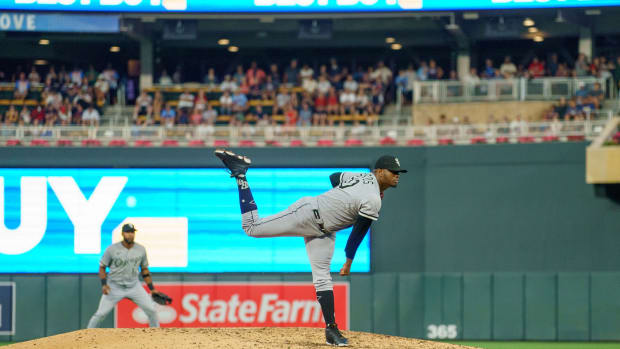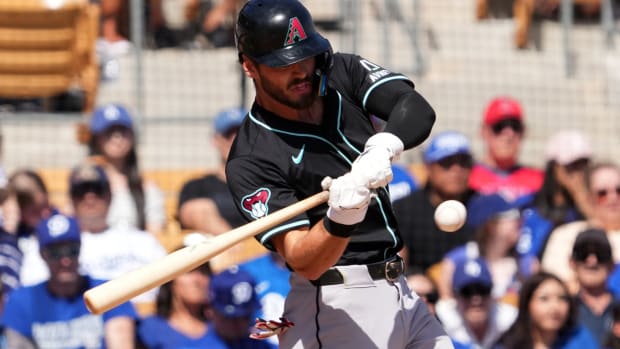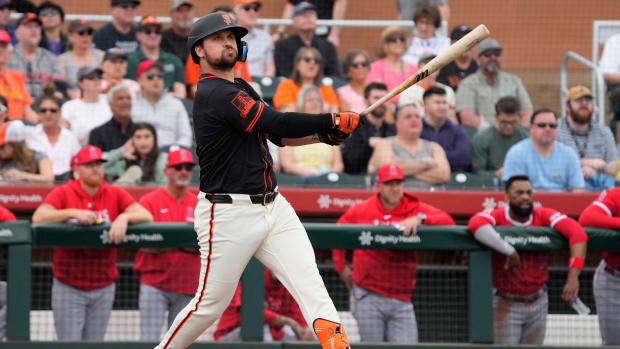Headfirst slides: Helpful, risky or both?
Even Pete Rose, the man who made the headfirst slide fashionable, says there's a time and place to be prudent.
As in, no need to get your nose bashed in at home plate.
''You don't want to slide headfirst into shin guards,'' said Rose, who played the most games in big league history.
If Rose played today, his signature dives wouldn't be much of a novelty. It's become common in the majors for runners to fling their arms out, lead with their faces and hurtle toward bases.
But at what price?
Bryce Harper of the Washington Nationals, Yasiel Puig of the Dodgers and Josh Hamilton of the Angels are among the stars who have gotten hurt sliding that way this year.
Nolan Arenado of the Rockies, Mike Napoli of the Red Sox and Ryan Zimmerman of the Nationals are on the list, too.
So many injuries, in fact, that many wonder whether the move is safe, or should be banned.
Tampa Bay's Ben Zobrist recently slid headfirst while trying to steal second base and dislocated his left thumb. A decade ago, he was yanked from a game while in the Houston system - the Astros had instructed minor league managers to immediately pull any player sliding headfirst into first base or home.
Zobrist has no plans to stop.
''I'll keep sliding headfirst,'' the All-Star said. ''Probably with an oven mitt on my hand - or something to protect it.''
That's what New York Yankees leadoff hitter Brett Gardner does. When he gets on base, he puts a cutoff elbow sleeve made of synthetic rubber over his hand.
''If it happened to get stepped on, it definitely protects me more so than not having anything at all. The main thing with me, it keeps all my fingers together so when I slide headfirst, maybe my finger doesn't get caught on a base,'' Gardner said.
Rose's slides helped solidify his reputation as one of the game's rough-and-tumble performers, and the image of him sailing through the air, arms extended, lives on.
Rose brought a style all his own to the field. He'd use more of a diving motion - he'd also elevate his legs, figuring that made him more likely to get hit by a throw on a close play.
He was willing to risk scrapes, he just wanted to avoid really hurting his legs and feet.
''I'd rather get spiked on my arm or my elbows or my shoulder,'' he said.
Detroit Tigers speedster Rajai Davis takes a more standard approach to headfirst slides, staying low to the ground and launching himself across the dirt. The landing is a little more gentle that way.
''The Pete Rose, that's not a good slide in my opinion,'' Davis said. ''Of course, it worked for somebody else. That's why he's Pete Rose.''
Whichever way a player does it, Rose still believes there are benefits to going headfirst. Runners can adjust in mid-slide to avoid a tag, and Rose says they might have an easier time seeing the ball.
''You go into second and the ball squirts away from the fielder, your peripheral vision's going to pick the ball up,'' Rose said.
No less a baserunning authority than Rickey Henderson - the career leader in steals - used to go headfirst as well.
For years, the different slides have led to a debate: Is one way faster than another?
Research by professor David Peters of Washington University in St. Louis has suggested that sliding headfirst can help a runner reach the base more quickly, but only by a small fraction of a second. He also says going feet first can be more practical because a player can pop up quickly and head to the next base if need be.
Harper, who has said he tries to emulate Rose's all-out style, hurt his left thumb in April diving into third.
Puig hurt his left thumb early this season plunging into first.
Hamilton tore a ligament in his left thumb flying into first. In 2011, a year after winning the American League Most Valuable Player award, he broke his upper right arm while diving toward home plate.
But Texas manager Ron Washington, who had Hamilton on his team a few years ago, doesn't expect anyone to stop going headfirst.
''I don't think you can put a rule on that. Let them know that it's not something you want to see, and to stop it, but when you compete, you're going to do what you've got to do to compete,'' he said. ''Sometimes, the headfirst thing is just natural, it just happens.''
Detroit manager Brad Ausmus suggested the bases themselves - made from hard rubber - might be made softer to reduce the risk of finger injuries.
Sometimes, a headfirst slide can have more catastrophic consequences. In 2011, Arizona State's Cory Hahn fractured a vertebra in his neck when his head struck the knee of an opposing second baseman.
Rose says he wouldn't advocate going headfirst into home or first, but some players aren't convinced that sliding headfirst is more dangerous. Take Toronto Blue Jays star Jose Reyes.
''I feel more safe sliding headfirst because I've already had two major injuries with my ankle sliding feet first,'' Reyes said. ''After that, you just go that way. I feel like I get to the base a lot faster when I do that.''
Reyes said he wears a protective brace on his wrist when running the bases, and he has scars on his fingers from sliding.
The Tigers don't have any hard-and-fast rules, but would rather their minor leaguers lead with their feet.
''If you get a guy that's a headfirst slider, we don't tell him, `You can't do it.' But we tell him, `We don't want you to do it.' And we tell him why. It's just kind of dangerous,'' assistant general manager Al Avila said.
Reyes figures there's a risk either way. And as long as high-profile players like him are diving into bases, that style will probably remain a big part of the game, risks and all.
''I've jammed my fingers, of course, because I go headfirst slides all the time, but nothing serious, thank God,'' Reyes said. ''If you think about injuries when you play, you're going to get injured. You just need to let it fly and let whatever happens, happen.''


































